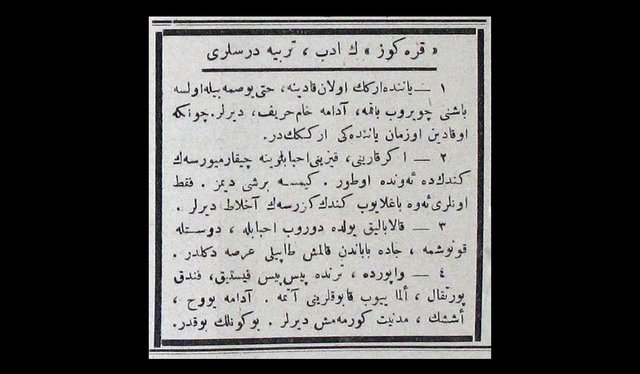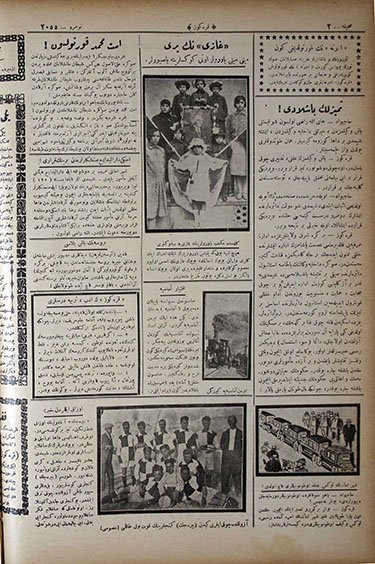Today in 1920s Turkey: 26 November 1927 (Karagöz’s Lessons in Good Manners)

(Short column, Karagöz, 26 November 1927, no. 2055, page 2.)
English
Karagöz’s Lessons in Etiquette and Good Manners
Do not turn your head to look at a woman who has a man with her, even if she is attractive; they call that kind of a man a crude bloke.
If you do not let your wife or your daughter go out to your friends’ with you, then you should sit at home, too. Nobody would say anything. But if you are attaching them to the home while you go out, that is called boorishness.
Do not stand in the crowded road and chat with your buddies and friends, the street is not the registered property left from your father.
Do not eat peanuts, hazelnuts, oranges, apples on the ferryboat or train (all nasty) and throw their refuse about. They call those guys mules and uncivilized. That is all for today.
Türkçe
Karagöz’ün Edep, Terbiye Dersleri
Yanında erkek olan kadına, hatta yosma bile olsa başını çevirip bakma, adama ham herif, derler. Çünkü o kadın o zaman yanındaki erkeğindir.
Eğer karını, kızını ahbaplarına çıkarmıyorsan kendin de evinde otur. Kimse birşey demez. Fakat onları eve bağlayıp kendin gezersen ahlat derler.
Kalabalık yolda durup ahbapla, dostla konuşma, cadde babandan kalmış tapulu arsa değildir.
Vapurda, trende pis pis fıstık fındık portakal, elma yiyip kabuklarını atma. Adama yuh, eşek, medeniyet görmemiş derler. Bu günlük bu kadar.
Comments:
This brief “lesson” on social etiquette could just as well be inspired by a particularly eventful commute home after work by a tired, short-nerved Karagöz columnist. Here, the didactic text takes us from mixed-sex public spaces to private homes and from Istanbul’s crowded streets to the city’s transportation services offering the reader examples of poor social behavior from loitering to littering. One should not stare at a woman who is with another man, but should also allow women the fair option to socialize. One should not block busy roads with trivial chitter-chatter. In the case of the fourth point, the author objects to eating in public and the throwing about of food shells, peels, and cores.
While personal complaints disguised as informal public service announcements are also commonly seen in newspapers at this time (see, for instance, this post about loud gramophone music), the current “lesson” is in fact a recurring theme in journals like Karagöz. This magazine and others like it saw the popular press as a tool for edifying the masses and introducing them to more current “civilized” behavior. Serial columns with names such as “Civilization Lessons” or Medeniyet Dersleri were particularly common from the mid-decade onward. Such content would include information about hygiene, male-female relations in an attempt to modify various behaviors and beliefs considered to be backwards, harmful, or otherwise “uncivilized.”
Additional Note:
Another Today in 1920s Turkey covered other content from this very issue (and very page) of Karagöz. For more on today’s issue see post #34: Woman Escapes Prison. Again.

(Entire page, Karagöz, 26 November 1927, no. 2055, page 2.)
This article has been updated and modified from its first iteration published right here on Steemit on 26 November 2017. For the original version see:
126. Today in 1920s Turkey: 26 November 1927 (Karagöz’s Lessons in Good Manners)